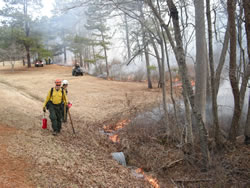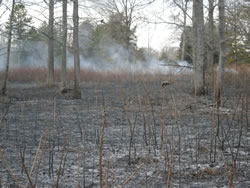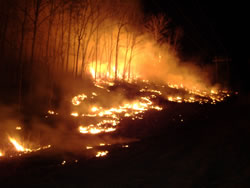
National Fire Plan Success Story
Prescribed Burns Restore Ecology and Historic Landscapes while Reducing Hazardous Fuels at Revolutionary War Battlefields
Cowpens National Battlefield and Kings Mountain National Military Park, South Carolina
National Fire Plan - Fuels Reduction
2011

Members of the Cumberland Gap Wildland Fire Module conducting ignitions at Cowpens. NPS photo by Chris Revels.

Turkeys foraging in the black, minutes after the burn at Cowpens. NPS photo by Chris Revels.

Nighttime fire behavior on the Saddleback burn at Kings Mountain. NPS photo by Chris Revels.
Prescribed burns in the South can have many objectives. Most burns consume built-up brush and other dead or dry vegetation to prevent them from becoming fuel for large, uncontrollable wildfires that might threaten lives or property. Many also restore or maintain fire-dependent or fire-adapted ecosystems, in which native plants and animals (such as wild turkey) benefit from frequent, low-intensity fires.
The National Park Service conducts prescribed burns at Cowpens National Battlefield and Kings Mountain National Military Park in South Carolina for all these objectives and more. Historical records from the Revolutionary War battles here describe a park-like, forested landscape with an open understory. These conditions were probably established and maintained by regular burning, either by European colonists or Indians.
In February 2011, National Park Service firefighters from the Cumberland Gap and Great Smokies wildland fire modules joined staff from Kings Mountain and Cowpens to complete a total of 823 acres of prescribed fire treatments at these two historic battlefields.
At Kings Mountain weather conditions and other variables allowed firefighters to work well into the evening hours. Lower winds and high humidity allowed firefighters to treat areas with considerable fuel loads without letting the fire behavior get too intense. The main ecological objective for this burn was to kill hardwood species such as tulip poplars, red maple, and sourwood, which had sprouted since the last burn, while preserving the oak and pine canopy.
Contact: Chris Revels, Chief Ranger, Kings Mountain National Military Park and Acting Superintendent, Cowpens National Battlefield, (864) 936-7921